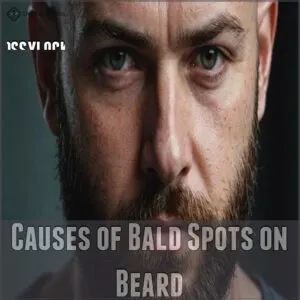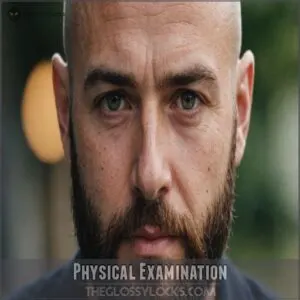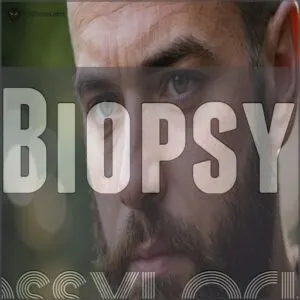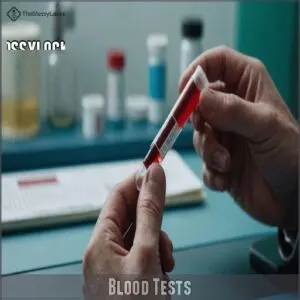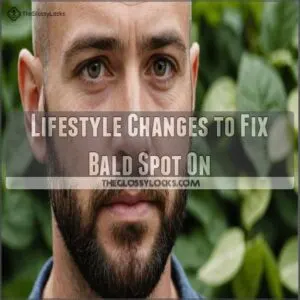This site is supported by our readers. We may earn a commission, at no cost to you, if you purchase through links.
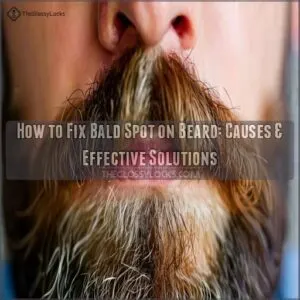 Fixing a bald spot on your beard doesn’t have to be rocket science.
Fixing a bald spot on your beard doesn’t have to be rocket science.
Start by eating healthy—think veggies and proteins—to boost hair growth.
Let your beard grow out; sometimes, patience is your best pal.
Take care of your beard with regular grooming and stress relief techniques like meditation or exercise.
Exercise can help by improving blood circulation, much like a river that needs a clean flow to thrive.
Try different beard styles that embrace your unique growth pattern.
If you’re feeling adventurous, treatments like minoxidil or a PRP session might do the trick.
Ready to explore more solutions?
Table Of Contents
- Key Takeaways
- Causes of Bald Spots on Beard
- How to Identify a Bald Spot on Beard
- Lifestyle Changes to Fix Bald Spot On
- Frequently Asked Questions (FAQs)
- How to prevent beard bald spots?
- Is there a cure for balding?
- How do you treat a bald patch in a beard?
- How to hide a bald beard?
- What causes a bald spot in your beard?
- Do bald spots affect your beard?
- Is there a way to fix bald spots in a beard?
- Can you actually fix a patchy beard?
- Can a bald spot grow back?
- Can patchy beard be fixed by shaving?
- Will minoxidil work for me?
- How long until I see results?
- Are there any side effects?
- Whats the best derma roller to use?
- Can I combine different treatments?
- Conclusion
Key Takeaways
- Start with a healthy diet rich in vitamins, leafy greens, and proteins to boost beard growth.
- Give your beard time to grow and consider different styles that suit your growth pattern.
- Manage stress with techniques like meditation and exercise to prevent hair loss.
- Explore treatments like minoxidil or PRP sessions if you are looking for more advanced solutions.
Causes of Bald Spots on Beard
So, you’ve got a bald spot in your beard?
Let’s explore the possible reasons behind this patchy situation, from pesky genetics and hormonal imbalances to less common culprits like fungal infections or even stress.
Genetics and Hormones
Blame genetics and hormones when beard bald spots sneak up on you.
Your family history can throw a wrench in your facial hair plans, thanks to hereditary factors.
Hormones, especially testosterone and dihydrotestosterone (DHT), play a pivotal role too.
Sometimes, hair follicle sensitivity or unresponsive androgen receptors make it tough for those robust whiskers to thrive.
Ain’t that a hairy situation?
Alopecia Areata
Alopecia areata can sneak up on you, leaving beard bald spots as an unwelcome surprise.
It’s an autoimmune disorder where your body mistakenly attacks hair follicles, causing patchiness.
You can explore Alopecia Areata products for managing symptoms and promoting hair growth.
Try Alopecia Areata treatments.
While it’s tricky, there are treatment options to
Fungal Infections
Imagine noticing a bald spot in your beard; fungal infections might be the culprit.
Here’s what you need to know:
- Ringworm Symptoms: Look for red, itchy patches.
- Tinea Barbae Treatment: Use antifungal medications for effective results.
- Beard Hygiene: Keep your beard clean to prevent infections.
Addressing these can steer you clear of a beard in distress!
Trauma or Injury
Fungal infections behind you, let’s tackle the impact of trauma or injury on your beard.
Shaving cuts and razor bumps are just the tip of the iceberg.
Alopecia barbae, an autoimmune disease that attacks hair follicles, can also lead to bald spots on the beard, and learning how to fix alopecia in beard can be helpful. Skin irritation from frequent shaving, beard burns, and ingrown hairs can cause those pesky bald spots and beard hair loss.
| Issue | Result |
|---|---|
| Shaving cuts | Beard bald spots |
| Razor bumps | Skin irritation |
| Ingrown hairs | Beard hair loss |
| Beard burns | Injury |
| Skin irritation | Trauma |
Nutritional Deficiencies
You’ve probably wondered if your patchy beard is due to nutritional deficiencies—it’s possible!
Boosting beard growth starts with a healthy diet.
Here are four key factors to keep in mind:
- Vitamins: Make sure you’re getting enough vitamins like A, C, and E.
- Deficiencies: Address any iron or zinc gaps.
- Food Sources: Eat leafy greens, almonds, and lean meats.
- Supplements: Think about beard supplements if needed.
Eating well nurtures not just your body but your beard too!
Stress
While lacking nutrients can hinder beard growth, stress also wreaks havoc, leading to patchy spots.
Picture your body throwing a tantrum, responding to stress with conditions like telogen effluvium, releasing stress hormones that cause hair loss.
Managing stress is key.
Try practicing stress reduction techniques like meditation or yoga to help combat this issue.
Remember, your beard might thank you with newfound fullness and vigor!
How to Identify a Bald Spot on Beard
Spotting a bald spot in your beard is easier than you think!
Just take a good look in the mirror—you’ll likely see a noticeably thinner or bare patch compared to the surrounding beard hair.
Physical Examination
Spotting a bald spot on your beard might feel like finding a needle in a haystack, but start with a visual inspection.
Check for sparse beard areas indicating patchiness or alopecia areata.
Observe hair growth patterns and scalp condition, noting that an itchy scalp doesn’t necessarily mean increased hair growth, but rather it could be a sign of underlying scalp health issues. Observe hair growth patterns and scalp condition.
If you’re unsure, consult a dermatologist who might recommend testing hair samples or a skin biopsy for a deeper analysis.
Fungal Culture
After examining your beard’s texture, consider delving into fungal culture to uncover hidden issues.
This scientific process helps identify pesky fungi causing bald spots.
It’s like detective work—focusing on culture types and results.
Preparing the culture sample might seem odd, but it’s essential for accurate interpretation.
With precise results, you’re closer to understanding your beard’s mysterious gaps, boosting beard growth and filling.
Biopsy
Considering a biopsy to pinpoint those pesky bald spots on your beard could be your next step to peace. A dermatologist will perform a tiny skin sample to nail the cause.
Stressing about risks or costs? Let’s break it down here:
- Biopsy results clarify conditions.
- Learn about alopecia areata.
- Explore biopsy alternatives.
- Consult on biopsy cost.
Blood Tests
While a biopsy sheds light on what’s happening with your skin, blood tests can dig deeper into any hidden culprits.
They check for thyroid function, and if you need a thyroid test kit, it’s important to know that these tests can provide insight, vitamin deficiencies, and iron levels that might be at the root of your patchy beard woes.
And hey,
Lifestyle Changes to Fix Bald Spot On
Picture your beard as a garden—sometimes, it just needs the right TLC to flourish.
Start by giving your diet a makeover. Foods rich in vitamins and minerals can spark beard growth, so toss in some leafy greens and nuts. A well-rounded diet that includes biotin, vitamin C, and zinc, as found in beard growth vitamins, can also support a healthy beard growth cycle.
Exercise isn’t just for muscles; it boosts testosterone, giving beard growth a nudge.
Identifying and addressing underlying issues like alopecia areata barbae
Frequently Asked Questions (FAQs)
How to prevent beard bald spots?
To keep beard bald spots at bay, focus on a nutritious diet, plenty of sleep, and managing stress.
Use minoxidil or microneedling to boost growth.
Embrace different styles like goatees to work with what you’ve got.
Is there a cure for balding?
Finding a cure for baldness feels like chasing a rainbow.
While managing hair loss often involves addressing the underlying cause, such as reducing DHT production with DHT-blocking medications, treatments like finasteride and minoxidil can help manage hair loss.
Hair transplants offer another option, though results vary by individual.
How do you treat a bald patch in a beard?
Try letting your beard grow before judging the patch.
Eating growth-promoting foods, using minoxidil, or microneedling can help.
Peppermint oil or L-Carnitine may stimulate growth.
Maintaining a healthy lifestyle boosts results.
How to hide a bald beard?
Conceal a bald beard spot by trimming the surrounding hair to an even length, creating a full appearance.
Experiment with styles like stubble or a goatee.
Consider using a beard filler pencil for temporary coverage.
What causes a bald spot in your beard?
A lone patch in your beard feels like that one sock that vanishes.
Genetics often get the blame, sometimes low hormones or stress.
Occasionally, it’s alopecia or an adventurous fungus causing the vanishing act.
Do bald spots affect your beard?
Bald spots can make your beard look uneven, but here’s the silver lining: they give you an excuse to experiment with different styles, like a goatee or stubble.
Embrace the change and showcase your unique style!
Is there a way to fix bald spots in a beard?
You can try minoxidil, a proven hair-growth stimulant. Microneedling might also help. A healthy diet and lifestyle boost testosterone, aiding beard growth. Patience is key; it takes time!
Can you actually fix a patchy beard?
Yes, you can manage a patchy beard!
Try letting it grow for a few months, use minoxidil or microneedling for stimulation, and don’t forget those beard-promoting foods.
Embrace styles like goatees or short boxed beards.
Can a bald spot grow back?
Sometimes, a bald spot can grow back with the right approach.
Factors like nutrition, reduced stress, and products like minoxidil or derma rollers play a role.
Patience is key, as hair regrowth varies from person to person.
Can patchy beard be fixed by shaving?
Imagine waking up with a perfect beard, only to find those pesky patches sneaking back.
Shaving won’t magically fill them in, but it can encourage even growth and a fresh start.
Mix it with patience and care.
Will minoxidil work for me?
Trying minoxidil for your beard might just do the trick.
It’s proven to stimulate hair growth, though results can vary.
Be patient and consistent, as it typically takes months to see noticeable changes.
How long until I see results?
Don’t worry if you’re anxious about the wait—results from using minoxidil could start to appear in around two to four months.
Patience is key here, so give it time and stick to your routine consistently.
Are there any side effects?
Using treatments like minoxidil for beard patches can cause side effects such as skin irritation, dryness, or redness.
Microneedling might lead to temporary discomfort or redness.
Always patch test skin products to avoid surprises.
Whats the best derma roller to use?
Like Daedalus crafting wings, choose a derma roller wisely! Consider needle length (25-5mm for the face), material (titanium’s best), and reviews. Prioritize hygiene; sterilize it before each use.
Can I combine different treatments?
Absolutely, combining treatments can be effective.
Try mixing minoxidil with microneedling to boost growth, sprinkle in a healthy diet, and add some exercise.
Monitor results closely, though, and adjust as needed for the best outcome!
Conclusion
Did you know about 10% of men experience bald spots on their beards?
If you’re dealing with a bald spot on your beard, there’s hope.
Understanding the cause, from genetics to stress, is key to finding solutions.
Simple steps like a balanced diet, regular grooming, and stress management can help.
Embrace your unique growth pattern, and don’t shy away from trying different styles or treatments like minoxidil.
Remember, patience and persistence are your best allies in tackling this issue.
- https://www.ncbi.nlm.nih.gov/pubmed/7126460
- https://en.wikipedia.org/wiki/Alopecia_areata
- http://suppversity.blogspot.com/2012/01/problems-with-high-or-low-dht-use-rice.html
- https://www.endocrine-abstracts.org/ea/0028/ea0028p313
- https://www.oatext.com/daily-intake-of-alfalfa-sprouts-but-not-broccoli-sprouts-influence-plasma-levels-of-androgen-in-middle-aged-males.php

